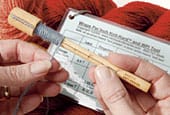One of my crafting goals that I set for myself way back at the beginning of the year was to learn how to spin. I had used a spindle on and off for a while, and felt that it was finally time to step it up a notch and try spinning with a wheel. It took a few bumpy starts, but once I got the feel for it I knew that I was completely hooked. I’ve been spinning up yarn faster than I can use it, and have gotten quite the ever-expanding fiber collection already!
However, the one thing I have noticed is that I am still in the learning process for spinning with a specific weight of yarn in mind. So far, I have been spinning away, happy to see how the fiber twists up and plies together – all with no specific end goals or projects in mind.
But for now, I am left with many skeins of yarn ranging from light sport all the way up through super bulky. So far, I’ve found myself spinning from 4oz. batts and rovings, which means that my finished product is going to be a single one-of-a-kind skein. This makes it tricky when it comes to using up my handspun yarn. I don’t want to fuss with too many gauge swatches to find out what weight of yarn I have, since it is already a limited quantity.
This is when I turned to wraps per inch as a tool to help me gauge my yarn!
WPI or wraps per inch refers to a way of measuring the thickness of a yarn. And although this is a term that is fairly well known among spinners, it can also come in quite helpful for knitters and crocheters as well! Using the WPI of a yarn helps you in determining the weight of the yarn and what the approximate gauge will be, which comes in extremely handy with yarn like handspun!
Since there are no labels or ball bands to refer to for your handspun yarns, you can instead turn to the WPI of your handspun to help you determine the weight, gauge, and what needles to use. And in the case of all those yarn odds and ends that have lost their labels, using the WPI really comes in useful for taking the guess work out of “gauging” your yarn stash. Or maybe you’ve found a pattern that you just love and you want to use up some of that yarn in your treasured stash, but you don’t know what yarn is what gauge? Again, wraps per inch to the rescue!
There are several ways of doing this, but I find the WPI Tool and Knit Card to be extremely handy. Here is a quick guide to measuring the wraps per inch of a yarn with the help of the WPI tool.
1) Hold the WPI tool in your hand and slide the yarn tail through the top slit to hold the yarn in place.
Normal
0
false
false
false
EN-US
X-NONE
X-NONE
2) Simply grab the leftover yarn you would like to use and
follow these three easy steps. Slide the yarn through the guide and down towards the wooden handle. Lightly guide the yarn around the handle and begin twisting. Continue to wrap the yarn around until you have reached at least the one inch mark. If you are using a “hairy” or “bumpy” yarn you need to allow space between each wrap and may want to continue to wrap to the 2 or 3 inch mark.
3) When you have completed your wraps, count the number of
rows that were created on the handle. If you only wrapped to the one inch mark then
the number you have counted is the number you should use on the corresponding reference
card. If you have gone past the one inch mark you must remember to count the total wraps
and divide by either 2 or 3 depending on where you stopped wrapping. Take the number
of rows and move across the top row of the reference chart (below) until you have found a
category it will fit in. Check the gauge icon directly above; this is the weight or gauge of
the yarn you measured.
And there you have it! It is that simple to measure your WPI or wraps per inch for any handspun or other yarn that you may have hanging out in your stash without the ball band.
As for my spinning, I can tell that spinning up a fiber with a specific weight in mind from the beginning is going to be my next challenge. But in the meantime, I’ve found using the WPI is a great trick to use for my stash of handspun yarns.
You can find the WPI Tool shown in the pictures here:
Do you have any other spinning tips or tricks for me? I’d love to hear them!




